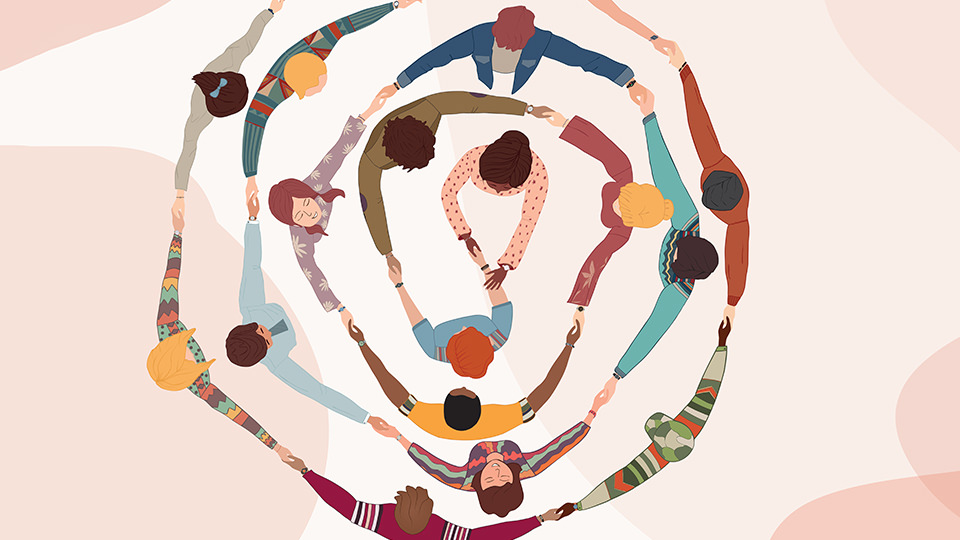

Synod as Traditioning: Part Two
Matthew Neugebauer
Friday, December 16, 2022

iStock photo by melitas
Partnering with the Faithful
In Part One, I raised the possibility that the Synod on Synodality is both a microcosm of the millennia-long process of Tradition, and an active participant in that process. I then paused to explore the Scriptural meaning of the word “Tradition,” specifically, the way the first Christians handed on and widely shared the Apostles’ encounter with the Risen Christ. In Part Two, I’ll explore what it might mean for lay people to have a role in this act of sharing and handing on, to be more active participants and partners in the Traditioning process through the Synod on Synodality. Our comprehension of the role of lay people in the development of Catholic doctrine isn’t all that new, at least the way we think of “new” in twenty-first century western society. In 1859, St. John Henry Newman expounded on this role in the short article “On Consulting the Faithful in Matters of Doctrine.” He articulated the perspective that the laity are able to actively confirm in their consciences what the pope and bishops have pronounced. This “active confirmation” is better known as the sensus fidelium – the “sense of the faithful” — which the Catechism calls a “supernatural appreciation of faith.” (CCC 92). It’s a way for the Holy Spirit to affirm that those holding Magisterial office have, in fact, got it right. Newman’s example was the straightforward case of Pius IX’s formal proclamation of the Dogma of the Immaculate Conception, a belief that emerged through centuries of popular devotion and reflection alongside academic speculation on Scripture. The faithful fully received what was handed down from the hierarchy, since they possessed it already. This may still seem like a “top-down” model, and until now it has often functioned that way: pope and bishops teach and direct, parish clergy and lay people receive. This “top-down” way of traditioning may well be the path that the synod on synodality ultimately follows, at least at the Universal Phase of the Synod of Bishops. Some of the Ecclesial Assemblies might also defer to the bishops among them in more significant ways than others. Even in the Diocesan Phase, the relative weight of lay and parish consultations differed from region to region and from country to country. But Newman’s idea hasn’t always operated in such a top-down manner. Over a century after “On Consulting the Faithful,” the bishops at Vatican II turned to address the challenges and opportunities of emerging religious pluralism in the West and the struggles of minority Catholic populations throughout the world. They listened to the experiences of lay people and parish clergy who had to work with, meet, and befriend those of other faiths on a daily basis, as well as those of no faith at all. This was a world where “state Catholicism” made no sense, despite centuries of magisterial support for it. The result was the Council's 1965 Declaration Dignitatis Humanae, a carte blanche endorsement of religious freedom as an essential bulwark of human dignity. Commentators debated whether this was a rupture from long standing papal policy or a development on it, and if “development of doctrine” was even possible. But it was beyond debate that the Council's conclusion relied on the contribution of lay faithful and their experiences. The Synod on Synodality’s Working Document suggests something along the lines of what led to Dignitatis Humanae, in an even more robust and comprehensive way. The October 2022 document is the first time we’ve had a global survey and synthesis of the state of the sensus fidelium, the clearest snapshot, in a formal, succinct, 40-page package, of how much (and how little?) some teachings handed down from the magisterium have been received. Graciously, lay people and parish clergy have told the hierarchy “what they really think,” and those perspectives have been handed on to the Continental Assemblies unfiltered, even if summarized in part by Episcopal Conferences. LGBTQ experiences, beliefs about women’s ordination, and devotion to the Extraordinary Form are all presented, or at least mentioned, in neutral tones. However, telling someone what you think is not the same as telling someone what to do. The model shown in the Diocesan Phase, as represented by the Working Document, doesn’t represent some “upside-down church” that puts all lay people in charge. The fidelium, properly understood, involves clergy and laity discerning together. Accordingly, the Working Document points the way to something far more profound, and far more faithful, than a lay-run Church. It points to a deepened partnership between all voices in the Church in discerning truth and handing on the faith of the Church. The Synodal Path’s greatest gift to the Church may well be to develop this method of discernment and transmission into a more consistent habit, a development that will likely entail some structural reform as well. The synod is seeking to hand over to the future culture of the Church the belief that this partnership is a good idea, that this is what it looks like for us to faithfully listen to the Holy Spirit, who “guides us into all truth.” (John 16:13) The Continental Assemblies will provide clearer examples of what this structural and habitual partnership might entail, since they are mandated to gather bishops, priests, religious, and lay people together in conversation. To take our most immediate example, the North American assembly, which began on December 14, is meeting in a series of ten online sessions that include three to five delegates from each of North America’s 268 dioceses, alongside any bishops who want to join in. Two sessions will be in French, three will be in Spanish, and five will be in English. Up to 1,340 lay people, parish clergy and religious might take part in the online meetings, along with about 500 bishops. Neither amount is likely to come close to those figures, but the proportions themselves give weight to the bishops’ commitment, as expressed by newly elected USCCB president Archbishop Timothy Broglio, that they are there to listen as much as lead. The intentional selection of lay delegates and the more accessible online format are meant to create “opportunities to listen to the concerns of different people,” Archbishop Broglio said to Vatican News in November. What might this gift of renewed structural partnership concretely result in? Naturally, there’s no way to know for sure, but the question warrants some reasoned speculation. An immediate litmus test will likely be the way the Ecclesial Assemblies, as temporary partnership structures in their own right, address difficult, divisive issues. Next up is Part Three, where I’ll look at some of the challenges and opportunities facing the North American Assembly, in order to give a concrete sense of what this partnership might lead to. I’ll employ one of those controversial examples from the Working Document that I listed in Part One, the experience and place of LGBTQ Catholics.Related Articles:
<<













